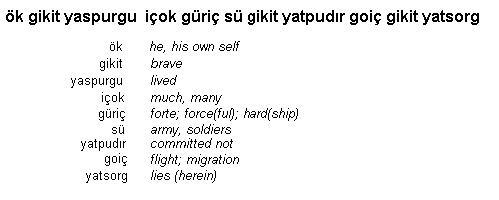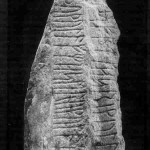The Istaby stone from Blekinge, which was carved in the transition period between the Primitive Norse period and Viking Age:

Reading the inscription from right to left:

he (who was) brave (and) lived through many hardships (of) army, committed not flight (or did not desert his post of duty) lies herein…
Truly a fitting epitaph for a soul who endured much in his wordly life.
 My deciphering ends here, because the photographs of only these three stones are supplied within the chapter titled “The Oldest Runic Inscriptions” in Prof. Jansson’s book. In conclusion, I admit that I might have made some minor mistakes and errors in my treatment of the subject. However, I hold the opinion that these stones do contain the messages of similar meanings in more or less the same way as I have striven to put forward. My purpose is to initiate a new interest in this ancient inscriptions and be of help in starting up a fresh discussion in regard to their contents. For this reason, I have not dwelt on speculative interpretations, but wanted to remark that the Primitive Norse futhark or the rune alphabet have stemmed from a much older common origin as that of the Göktürks.
My deciphering ends here, because the photographs of only these three stones are supplied within the chapter titled “The Oldest Runic Inscriptions” in Prof. Jansson’s book. In conclusion, I admit that I might have made some minor mistakes and errors in my treatment of the subject. However, I hold the opinion that these stones do contain the messages of similar meanings in more or less the same way as I have striven to put forward. My purpose is to initiate a new interest in this ancient inscriptions and be of help in starting up a fresh discussion in regard to their contents. For this reason, I have not dwelt on speculative interpretations, but wanted to remark that the Primitive Norse futhark or the rune alphabet have stemmed from a much older common origin as that of the Göktürks.
January 1994 Turgay Kürüm
Address Yeni Lara Yolu, Doktorlar Sitesi No:10 Guzeloba ANTALYA / TURKIYE
Tel: 90 – 242 – 349 51 41
Fax: 90 – 242 – 349 51 37
E-Mail : turgay@antalyaonline.net